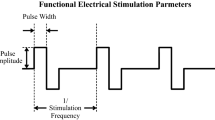Abstract
The combination of targeted muscle reinnervation (TMR) and pattern classification of electromyography (EMG) has shown great promise for multifunctional myoelectric prosthesis control. In this study, we hypothesized that surface EMG recordings with high spatial resolution over reinnervated muscles could capture focal muscle activity and improve the classification accuracy of identifying intended movements. To test this hypothesis, TMR subjects with transhumeral or shoulder disarticulation amputations were recruited. Spatial filters such as single differential filters, double differential filters, and various two-dimensional, high-order spatial filters were used, and the classification accuracies for fifteen different movements were calculated. Compared with monopolar recordings, spatially localized EMG signals produced increased accuracy in identifying the TMR patients’ movement intents, especially for hand movements. When the number of EMG signals was constrained to 12, the double differential filters gave 5–15% higher classification accuracies than the filters with lower spatial resolution, but resulted in comparable accuracies to the filters with higher spatial resolution. These results suggest that double differential EMG recordings may further improve the TMR-based neural interface for robust, multifunctional control of artificial arms.






Similar content being viewed by others
References
Basmajian, J. V., and C. J. De Luca. Muscles Alive : Their Functions Revealed by Electromyography. Baltimore: Williams & Wilkins, pp. xii, 561, 1985.
Disselhorst-Klug, C., J. Silny, G. Rau. Improvement of spatial resolution in surface-EMG: a theoretical and experimental comparison of different spatial filters. IEEE Trans Biomed Eng 44:567-74, 1997. doi:10.1109/10.594897.
Duda, R. O., P. E. Hart, and D. G. Stork. Pattern Classification. New York: Wiley, pp. xx, 654, 2001.
Englehart, K., B. Hudgins. A robust, real-time control scheme for multifunction myoelectric control. IEEE Trans Biomed Eng 50:848-54, 2003. doi:10.1109/TBME.2003.813539.
Englehart, K., B. Hudgins, P. A. Parker, M. Stevenson. Classification of the myoelectric signal using time-frequency based representations. Med Eng Phys 21:431-8, 1999. doi:10.1016/S1350-4533(99)00066-1.
Farina, D., C. Cescon. Concentric-ring electrode systems for noninvasive detection of single motor unit activity. IEEE Trans Biomed Eng 48:1326-34, 2001. doi:10.1109/10.959328.
Farrell, T. R., R. F. Weir. A comparison of the effects of electrode implantation and targeting on pattern classification accuracy for prosthesis control. IEEE Trans Biomed Eng 55:2198-211, 2008. doi:10.1109/TBME.2008.923917.
Graupe, D., J. Salahi, K. H. Kohn. Multifunctional prosthesis and orthosis control via microcomputer identification of temporal pattern differences in single-site myoelectric signals. J Biomed Eng 4:17-22, 1982. doi:10.1016/0141-5425(82)90021-8.
Hargrove, L. J., K. Englehart, B. Hudgins. A comparison of surface and intramuscular myoelectric signal classification. IEEE Trans Biomed Eng 54:847-53, 2007. doi:10.1109/TBME.2006.889192.
Hijjawi, J. B., T. A. Kuiken, R. D. Lipschutz, L. A. Miller, K. A. Stubblefield, G. A. Dumanian. Improved myoelectric prosthesis control accomplished using multiple nerve transfers. Plast Reconstr Surg 118:1573-8, 2006. doi:10.1097/01.prs.0000242487.62487.fb.
Hoffer, J. A., G. E. Loeb. Implantable electrical and mechanical interfaces with nerve and muscle. Ann Biomed Eng 8:351-60, 1980. doi:10.1007/BF02363438.
Huang, H., T. Kuiken, R. D. Lipschutz. A strategy for identifying locomotion modes using surface electromyography. IEEE Trans Biomed Eng 56:65-73, 2009. doi:10.1109/TBME.2008.2003293.
Huang, H., P. Zhou, G. Li, T. A. Kuiken. An analysis of EMG electrode configuration for targeted muscle reinnervation based neural machine interface. IEEE Trans Neural Syst Rehabil Eng 16:37-45, 2008. doi:10.1109/TNSRE.2007.910282.
Hudgins, B., P. Parker, R. N. Scott. A new strategy for multifunction myoelectric control. IEEE Trans Biomed Eng 40:82-94, 1993. doi:10.1109/10.204774.
Kuiken, T. A., D. S. Childress, W. Z. Rymer. The hyper-reinnervation of rat skeletal muscle. Brain Res 676:113-23, 1995. doi:10.1016/0006-8993(95)00102-V.
Kuiken, T. A., G. A. Dumanian, R. D. Lipschutz, L. A. Miller, K. A. Stubblefield. The use of targeted muscle reinnervation for improved myoelectric prosthesis control in a bilateral shoulder disarticulation amputee. Prosthet Orthot Int 28:245-53, 2004.
Kuiken, T. A., L. A. Miller, R. D. Lipschutz, B. A. Lock, K. Stubblefield, P. D. Marasco, P. Zhou, G. A. Dumanian. Targeted reinnervation for enhanced prosthetic arm function in a woman with a proximal amputation: a case study. Lancet 369:371-80, 2007. doi:10.1016/S0140-6736(07)60193-7.
Parker, P., K. Englehart, B. Hudgins. Myoelectric signal processing for control of powered limb prostheses. J Electromyogr Kinesiol 16:541-8, 2006. doi:10.1016/j.jelekin.2006.08.006.
van Vugt, J. P., J. G. van Dijk. A convenient method to reduce crosstalk in surface EMG. Cobb Award-winning article, 2001. Clin Neurophysiol 112:583-92, 2001. doi:10.1016/S1388-2457(01)00482-5.
Williams, T. W., 3rd. Practical methods for controlling powered upper-extremity prostheses. Assist Technol 2:3-18, 1990.
Zhou, P., M. M. Lowery, K. B. Englehart, H. Huang, G. Li, L. Hargrove, J. P. Dewald, T. A. Kuiken. Decoding a new neural machine interface for control of artificial limbs. J Neurophysiol 98:2974-82, 2007. doi:10.1152/jn.00178.2007.
Acknowledgments
The EMG signal classification code used in this study was provided by Professor Kevin B. Englehart, PhD, PE, of the Institute of Biomedical Engineering, University of New Brunswick, Canada. We thank Aimee Schultz, M.S. for editing the manuscript. This work was supported by the National Institute on Disability and Rehabilitation Research (Grant # H133F060029 & H133F080006), the NIH National Institute of Child and Human Development (Grants # R01 HD043137-01, #R01 HD044798, and # NO1-HD-5-3402), and the Defense Advanced Research Projects.
Author information
Authors and Affiliations
Corresponding author
Rights and permissions
About this article
Cite this article
Huang, H., Zhou, P., Li, G. et al. Spatial Filtering Improves EMG Classification Accuracy Following Targeted Muscle Reinnervation. Ann Biomed Eng 37, 1849–1857 (2009). https://doi.org/10.1007/s10439-009-9737-7
Received:
Accepted:
Published:
Issue Date:
DOI: https://doi.org/10.1007/s10439-009-9737-7




